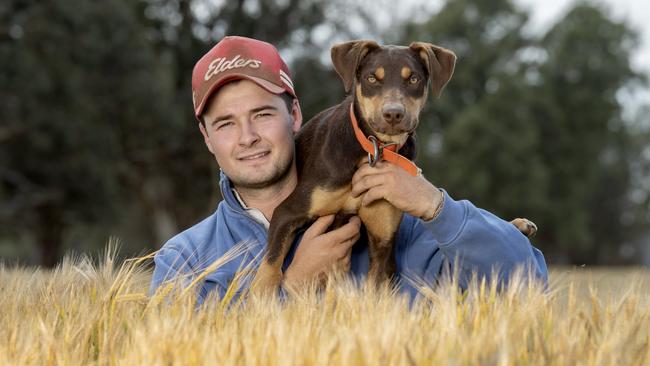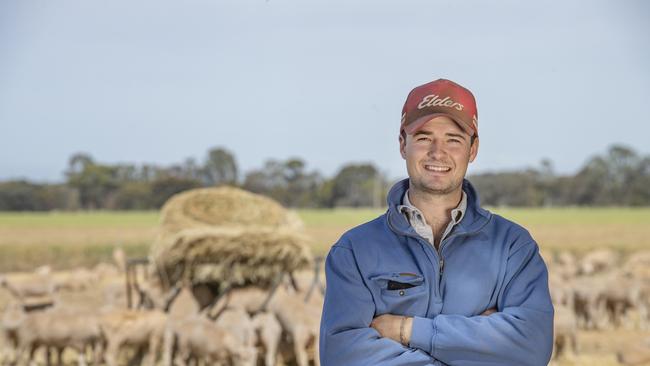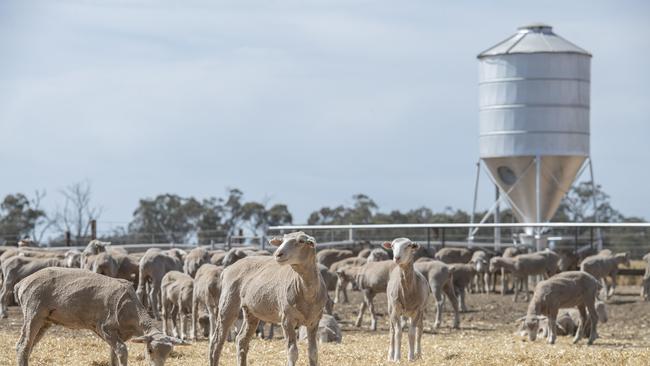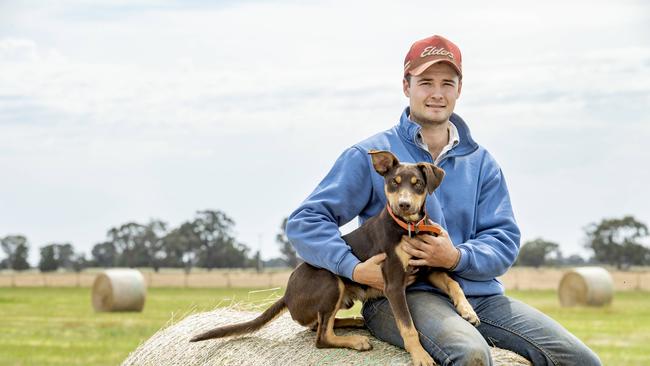Sheep and crop farmer Angus White
A 22-year-old Victorian farming star took some big risks to start his own farm, but now he is reaping the rewards. See his story.
At just 22-years-old sheep and cropping farmer Angus White has taken some big financial risks.
In the past few years, before many his age have even decided what career they want to embark on, Angus has leased a farm, bought a header and designed and built a sheep feedlot system.
And it’s all with his end goal in mind – to one day purchase his own farm.
Angus grew up on a cattle and cropping farm near Kerang, before his parents sold the family farm and moved to Axedale for him to finish high school.
“I tried electrical, concreting, plumbing, I tried them all, but it always felt like a job. When I finished year 12 I thought I’d study agronomy as that was the only way I could see to get into agriculture,” Angus said.
Then at just 19 the opportunity came up for Angus to lease his uncle’s property at Bears Lagoon, near Serpentine, and he jumped at the chance.
At the time he was working for animal nutrition company Ridley’s, and would take two weeks of leave to cut hay and then another two weeks for harvest, but soon realised it was too hard to do both.
“That was the scariest bit, quitting my job.”
But now approaching his fourth harvest, Angus is proving his big risks are paying off.

FORMULA FOR SUCCESS
Angus leases the 283ha property, which is basically all sown to crop, and has a 2500 sheep self-sufficient feedlot.
“It would be nice to have ewes and lambs, but the feedlot intensifies what I have and means I can free up paddocks for cropping or hay,” he said.
It means he can get the most out of the land he has available.
The crop rotation is decided in conjunction with an agronomist, but usually consists of barley, canola and vetch for hay.
Vetch hay and barley is fed to the sheep in the feedlot, while canola is sold “once it is in the bin”.
This year Angus planted 114ha of barley, 66ha of canola, 56ha of vetch and 45ha of a ryegrass, lucerne and clover mix for hay.
“Everything I do all works together, it also means there is variety and if one commodity is down then the others aren’t too bad.”
While he harvests his own crop, Angus also does some contract harvesting to increase cash flow.
Which means he took a big risk and purchased a second-hand header in 2020.
Angus said he had lambs in the feedlot at the time and had found a header he wanted to buy, but because he couldn’t get a bank loan, he took a risk and fed the lambs for longer to see if he could make a bigger profit.
And the risk paid off as he was able to purchase the header.
“I got the bug for feeding lambs after that.”

WORTH THE WEIGHT
First- or second-cross lambs are purchased at about 35kg liveweight and then sold at 55-60kg.
Angus said he buys off-farm earlier in the year and then buys through saleyards at Ballarat or Hamilton later in the year.
He doesn’t have a breed preference, but condition of the lambs was most important.
Angus said he usually has three main lots in the feedlot each year.
The sheep are typically fed for 10-12 weeks and have a weight gain of 300-350 grams a day.
“I try to sell direct to abattoirs, but it depends on the price, this year the forward contracts are out but they aren’t that high. I like selling direct because I have a guaranteed price, they’re weighed on-farm and we know what we are getting.”
“I had been working on an average of 550c/kg, then I work backwards from there.”
“I like to make a minimum profit of $20 a head, if I make more it’s a bonus, if less then I can adjust things.”
The lambs are fed a ration of barley and lupins or peas, whichever protein source is cheaper at the time.
Lambs are grazed on stubble when available and straw is baled behind the header for use in the feedlot.
When lambs are bought in they are usually shorn to “freshen them up” and it means they will have a “nice skin” by the time he sells them.
“You also get six weeks of good feed conversion because they are trying to put body fat back on as they’ve lost their insulation. Of course I need to be conscious of the weather though.”

HOME INVENTION
When it came to building the feedlot, Angus did a lot of research on the best design by visiting other feedlots and talking to farmers about what worked or didn’t work for them.
“I started off using Bromar lick feeders for the first year, but they are very labour intensive. I had to fill them every second day and cleaning them out when they got blocked was just taking up a huge part of my day.”
Wanting to feed lambs in the most cost effective and time efficient way, Angus started looking into automatic feeders but they were too expensive.
“As farmers we’re used to building our own things, so I started designing and made my own.”
Angus said a silo sits outside the pen with the feed and a centreless auger spirals the grain out into the trough which is shaped like a W. The troughs are all 18 metres long and when the grain gets to a sensor at the end, it stops the motor on the auger.
“It’s pretty basic, but it saves time and I can feed a lot more sheep.”
After building the initial four troughs, Angus has discovered things he can improve on and is now building a second feedlot, this time with four troughs at 24m each.
Other improvements include concrete bases, bigger gates and a laneway system for easy stock handling.
The feedlot also have custom built 150mm PVC pipe troughs, which keep the water fresh all of the time and means he is only dumping a bit of water when they get cleaned out.
There are also two shade sails in each pen to keep sheep cool.

RESEARCH PAYS
One of Angus’ key philosophies is to not work in isolation.
“I like to seek advice and talk to others, because if you isolate yourself you have no idea what’s going on,” he said.
Angus is constantly researching, talking to experts, networking and keeping up to date on markets and prices, to see how it will impact his business.
He said working with an agronomist and livestock agent was invaluable.
“The agronomist knows what is going on in the area and with other crops, and he gives recommendations which makes it easier to make decisions.”
“This year I was wanting to grow lentils, but my agronomist pointed out they don’t grow well in this soil and I’d be better off with vetch which would still add nitrogen to the soil. If I didn’t seek his advice I’d be wondering why that crop failed or didn’t do well.”
While he works mostly solo, Angus speaks to his Dad often for advice and his Mum helps out when it is busy, like at shearing, while his 17-year-old brother drives the header during harvest, and Angus drives the truck.
In the future Angus hopes to lease more land, and then own his own farm.
“It’s frustrating how hard it is for young people to buy land, but I can’t get caught up in that or looking at the big guys with jealousy, I prefer to look up to those bigger farmers who are successful and see what they’re doing and ask for tips.”
And on taking big risks, he said his biggest fear was regret.
“I just love it, there’s nothing else I would rather be doing.





